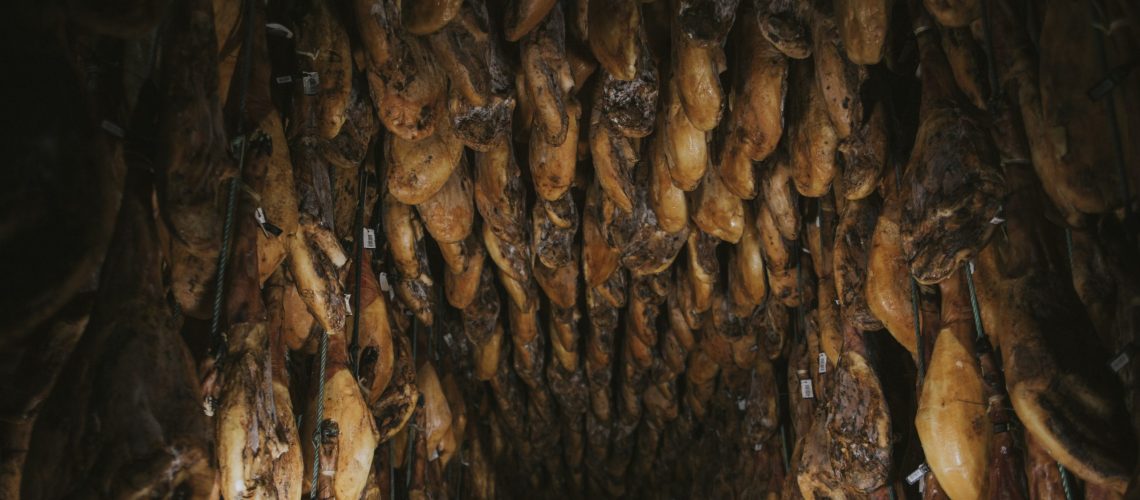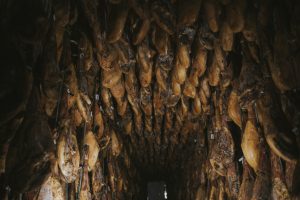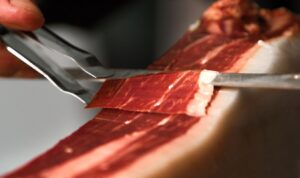The process of curing an Acorn-Fed 100% Ibérico Pork Ham is long and laborious, with various stages that require detail and care. The results, of course, are astounding and well worth the time and effort. The final stage of the lengthy curing process for both the ham (jamón) and shoulder (paleta) is called the secadero or maduracion, which essentially means the drying and maturing phase.
What is the secadero phase?
The goal of the secadero/maduración is to ensure the ham is completely shelf-stable. It’s also the moment where the ham develops its unique aromas and flavors. This step takes place in the curing cellars of southern Spain, where the temperature sits between 59ºF and 68ºF with a humidity level around 80-60%. The temperature and humidity is controlled simply by opening and closing the windows throughout the day, the traditional and natural way of monitoring these levels. On humid days, for example, it’s better to leave the windows closed so the humidity levels do not increase. This helps avoid any development of undesirable molds.
The Steps of the Secadero Phase
There are various steps within the secadero process. The first is what’s called the sudado, or “the sweat,” which takes place in the first summer of the curing process. Right before this first sudado step, the ham experts apply a layer of pork fat to the bone area. At this point, they also observe the aroma and visual aspects of the ham, tasting and testing constantly. They will actually hit the leg and listen for any hollow sounds, which can indicate a disturbance or alteration in the meat caused by interior gasses. The first sudado takes place at temperatures below 82ºF and lasts 35 to 40 days, usually ending around the end of August or beginning of September.
After the first sudado, the hams will stay in the drying room at room temperature until the next summer when they will go through a second sudado phase. From there, they are placed in the cellar and the maturation process starts. An Iberico ham must stay for at least 600 days in the drying room and cellar, while this stage usually lasts up to 36 months. On the other hand, the Paleta ibérica must spend at least 365 days in this phase, but it usually stays for up to 24 months.
It’s important to note that:
- In the maturation step, certain flavor nuances appear, like those nutty and cured aromas that are so characteristic of a quality Acorn-Fed 100% Ibérico Jamón or Paleta.
- The aroma compounds will concentrate and fully develop during this phase. The development of the final aroma of the ham, or what is called the bouquet, also occurs at this point.
- At the end of this phase the ham actually decreases in size by 35-39%.
- The total curing period of a Jamón Ibérico is almost 4 times longer than that of a Jamón Serrano.
Chemical Reactions in the Secadero Process
The secadero is a fascinating process full of chemical reactions. Just like cooking, the art of curing a jamón is all science.
- Enzymatic Proteolysis happens when the proteins break down and create soft textures in the meat. Peptides also develop, which add flavor and aromatic amino acids.
- Bitter flavors come from the amino acids histidine, tryptophan, isoleucine, tyrosine.
- Sweet flavors come from the amino acids glycine, serine, alanine, threonine, leucine.
- Umami flavors from the amino acids aspartic and glutamic acid.
- The “sudado” of the ham’s fat is a result of a ruptured adipocyte. It causes a homogeneous drying of the ham, as well as flavor development. High temperatures and low humidity (less than 75%) are an important component of this reaction.
This important and traditional process of curing is what gives our hams and pork shoulders such an exceptional and award-winning flavor that has stood the test of time.






